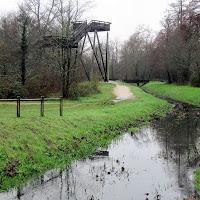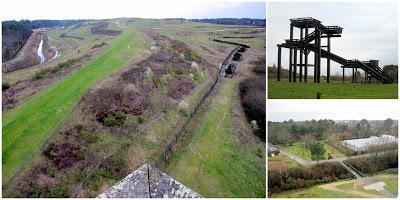 As well as being a marvelous place for a relaxing stroll, the Écosite du Bourgailh in Pessac is a case study in innovative regeneration.
As well as being a marvelous place for a relaxing stroll, the Écosite du Bourgailh in Pessac is a case study in innovative regeneration.Le Bourgailh is a 160-acre landscaped section of the green belt that runs between the Rocade ringroad and the source of the Peugue river, which was for centuries part of the lifeblood of Bordeaux but has long been driven underground nearer the city until it flows into the Garonne at the end of Cours Alsace-Lorraine.
The Bourgailh development came about in 1989 as the town of Pessac became increasingly concerned about the number of houses that were being built where forests and greenery used to be. As well as acquiring properties that ran along the Peugue, the town decided that the former rubbish tip, which subsequently closed in 1991, would be converted into this vast complex given over to discovering and exploring nature and wildlife.
The Bourgailh project which came to be was funded by the greater Bordeaux authority (Communauté Urbaine de Bordeaux, CUB) in partnership with the towns of Pessac and Mérignac. Landscape architects Jacques Coulon and Linda Leblanc dreamt up the paths that wind through the forest and the three wooden observation decks that range in height from 12 to 18 metres. Looking out on a clear day from the tallest tower (“Palier de l’Écureuil”), the skyline of Bordeaux can be seen in the distance, and when scanning around other landmarks that can be spotted include the Pont d’Aquitaine and the control tower of Mérignac airport.

The view from the 18-metre-high "Palier de l'Écureuil"...over a former
rubbish tip, a biogas conversion unit and large greenhouses, more of which below!
In the foreground is an uninviting mound containing the remains of years of communal domestic waste. The toxic mound will remain out-of-bounds for the general public until at least 2021, but in the meantime the rotting waste is being put to good use: an experimental biogas power generation system has been implemented.
Biogas is a form of combustible gas made up of methane and carbon dioxide, the direct result of the decomposition by fermentation of organic matter. At Bourgailh, the biogas is harnessed underground and powers a 22kW engine coupled with an asynchronous generator which can switch between biogas and conventional power supply systems. At this point in time, around 400 cubic metres of biogas (one cubic meter is equivalent to 1 liter of petrol) is extracted every hour at Bourgailh, and the gas comprises around 35% of methane, i.e. around one third of that contained in natural gas. Given the current state of the former rubbish tip, it could conceivably continue to yield biogas in this manner for another decade or so.
With a view to capitalising on the experimental system, the biogas output at Bourgailh is regularly monitored by electricity supplier EDF’s Research and Development unit in Karlsrühe (Germany) to assess integration issues, levels of reliability, energy and environmental performance, maintenance operations, technical aspects and the overall financial implications of the installations.

The botanic greenhouses and some of the educational exhibits that are on show.
Meanwhile, the energy that is generated is used to power (heat and light) the nearby greenhouse installations, which are open to the general public from April to October of each year (the main park is open all year round). The spectacular greenhouses are home to an extensive collection of tropical plants (4,000 plants of 1,300 different varieties).
Coupled with the greenhouse installations are allotments that are used for educational purposes, and various exhibits that demonstrate how insects interact with plants. Elsewhere in the Bourgailh park, further sights to behold include beehives and a lengthy alley flanked by an impressive number of different varieties of holly!

Beehives (two labelled "CUB", the other "Pessac")
and one of the many varieties of holly that can be seen in the park.
Throw in a rich programme of cultural and artistic events, seminars and activities for schoolchildren, and you’re left with one of the most active venues in the Bordeaux region which consistently proves to be a popular draw for visitors.
- Find it: Site du Bourgailh, Avenue de Beutre, Pessac.
- Website: www.bourgailh-pessac.fr
- Map of the Pessac green belt here and an introduction to the wooden viewing platforms built in Pessac and elsewhere by Jacques Coulon and Linda Leblanc: www.belvederes.fr
